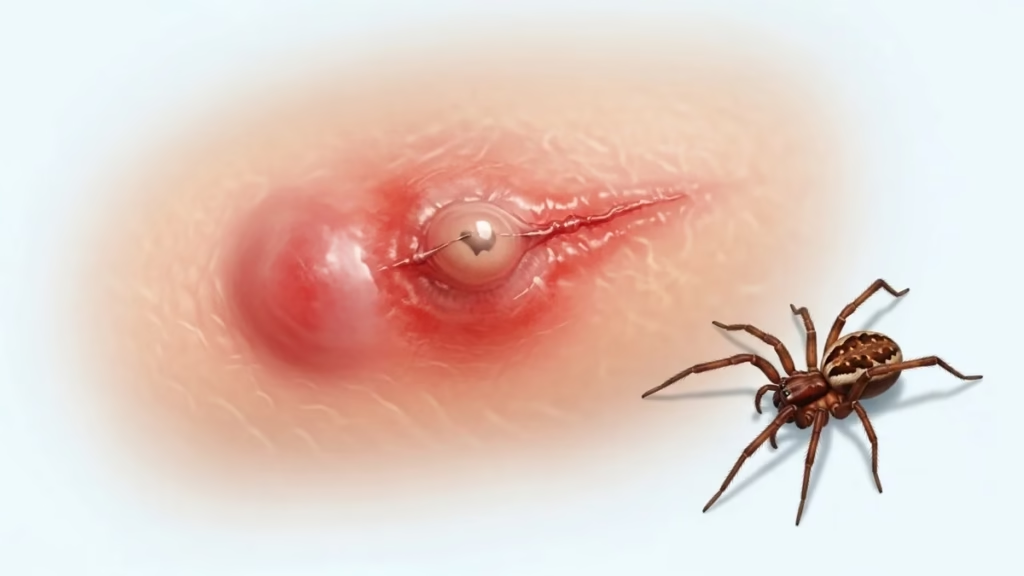Introduction
A brown recluse bite is one of the most concerning spider bites in the United States. While most spider bites are harmless, the brown recluse (Loxosceles reclusa) can cause significant skin damage, severe pain, and, in rare cases, systemic illness. People often mistake its bite for infections like MRSA or other skin conditions, making proper diagnosis crucial.
In this blog, we’ll cover everything you need to know about a brown recluse bite, including symptoms, stages, treatment, complications, and prevention.
What is a Brown Recluse Spider?
The brown recluse spider is a venomous spider native to the central and southern United States. It is typically identified by:
- A light to dark brown color
- A distinct violin-shaped marking on its back
- About 6 eyes instead of 8, arranged in pairs
- Preference for dark, undisturbed places like basements, attics, and closets
Unlike aggressive spiders, brown recluses bite only when provoked or trapped against the skin.
What Does a Brown Recluse Bite Look Like?
A brown recluse bite can vary in appearance depending on the individual and severity. Initially, the bite may look mild but worsen within hours to days.
Early Symptoms (0–8 hours):
- Redness and swelling around the bite site
- Mild burning or stinging sensation
- Small blister formation
Progressive Symptoms (1–3 days):
- Enlarging wound with blue, purple, or black discoloration
- Pain that increases over time
- Development of a blister or ulcer
Severe Cases (3–10 days):
- Necrosis (death of skin tissue)
- Open sores that may take weeks to heal
- Fever, chills, and body aches (in rare cases)
Brown Recluse Bite Stages (With Timeline)
| Stage | Timeframe | Symptoms |
|---|---|---|
| Stage 1 | 0–8 hours | Redness, swelling, mild burning |
| Stage 2 | 1–3 days | Enlarged wound, blister, increased pain |
| Stage 3 | 3–10 days | Tissue necrosis, blackened skin |
| Stage 4 | Weeks | Slow healing, possible scarring |
Common Symptoms of a Brown Recluse Bite
- Pain at the bite site (gradually worsening)
- Red, purple, or blue wound
- Itching and irritation
- Fever and chills (systemic involvement)
- Fatigue, nausea, or muscle pain in rare cases
When to See a Doctor
Seek immediate medical care if you experience:
- Severe pain at the bite site
- Rapidly spreading redness or swelling
- Fever, body aches, or nausea
- Development of an open sore or black tissue
- Signs of allergic reaction (difficulty breathing, dizziness, swelling of lips/tongue)
How is a Brown Recluse Bite Diagnosed?
Doctors often diagnose based on:
- Physical Examination – looking for the classic wound pattern
- Patient History – whether you live in or visited areas where brown recluses are common
- Rule Out Other Conditions – such as staph infections, diabetic ulcers, or shingles
Since spider bites are frequently misdiagnosed, accurate reporting of symptoms is essential.
Treatment for Brown Recluse Bite
Treatment depends on the severity of the bite.
First Aid at Home:
- Clean the wound with mild soap and water
- Apply ice packs (10 minutes on, 10 minutes off) to reduce swelling
- Elevate the affected area to slow venom spread
- Avoid strenuous activity, as it may worsen symptoms
- Take over-the-counter pain relievers like acetaminophen or ibuprofen
Medical Treatments:
- Antibiotics for secondary infections
- Corticosteroids in some severe cases
- Surgical intervention (rare, for necrotic tissue removal)
- Hyperbaric oxygen therapy (in some cases to promote healing)
Complications of a Brown Recluse Bite
Most bites heal within 3–6 weeks, but complications may include:
- Permanent scarring
- Skin grafts (for large necrotic wounds)
- Systemic illness with fever, anemia, or kidney problems (rare)
Brown Recluse Bite vs. Other Spider Bites
Not all spider bites are dangerous. Here’s how a brown recluse bite differs from others:
| Spider Bite | Appearance | Severity |
|---|---|---|
| Brown Recluse | Necrotic, ulcer-like sore, purple/black center | Moderate to severe |
| Black Widow | Red spot with muscle cramps, abdominal pain | Severe systemic symptoms |
| Common House Spider | Red bump, mild itching | Harmless |
| Wolf Spider | Swollen, painful bump | Mild, no necrosis |
How to Prevent Brown Recluse Bites
Since prevention is easier than treatment, follow these tips:
- Shake out clothing and shoes before wearing
- Wear gloves when cleaning garages, basements, or attics
- Keep storage areas clean and clutter-free
- Use sticky traps in areas where spiders are suspected
- Seal cracks and gaps in walls, doors, and windows
- Store firewood away from the house
Brown Recluse Bite Myths vs. Facts
- ❌ Myth: Every brown recluse bite leads to necrosis.
✅ Fact: Most bites heal without severe tissue damage. - ❌ Myth: Brown recluses are aggressive.
✅ Fact: They bite only when provoked. - ❌ Myth: All spider bites need antivenom.
✅ Fact: There is no specific antivenom for brown recluse bites; treatment focuses on wound care.
Recovery and Healing Timeline
- Mild bites: Heal in 1–3 weeks
- Moderate bites: May take 4–8 weeks, often leaving minor scars
- Severe bites: Require months to fully heal, sometimes needing surgery
Frequently Asked Questions (FAQs)
1. How dangerous is a brown recluse bite?
Most bites are mild, but some can lead to serious tissue damage and systemic illness. Immediate care reduces risks.
2. Can a brown recluse bite kill you?
Fatalities are extremely rare but possible in children or individuals with weakened immunity.
3. What should I do immediately after being bitten?
Wash the bite, apply ice, elevate the area, and seek medical attention if symptoms worsen.
4. How long does it take to heal?
Healing may take anywhere from 2 weeks to several months depending on severity.
5. Can antibiotics cure a brown recluse bite?
Antibiotics don’t affect the venom but may be prescribed if secondary infection develops.
Conclusion
A brown recluse bite can be alarming due to its potential for tissue damage, but most cases resolve with proper wound care and medical attention. Recognizing the signs early, seeking timely treatment, and taking preventive steps can minimize risks and complications.
If you suspect a bite, don’t panic—but don’t ignore it either. Quick action ensures the best outcome.
For more health guides, visit our Health & Wellness Blog.
You can also check reliable medical resources such as:







